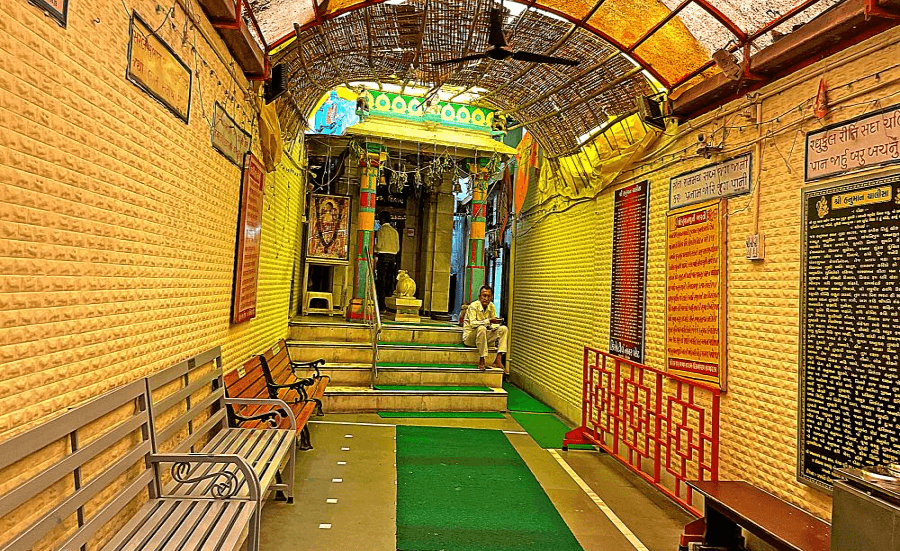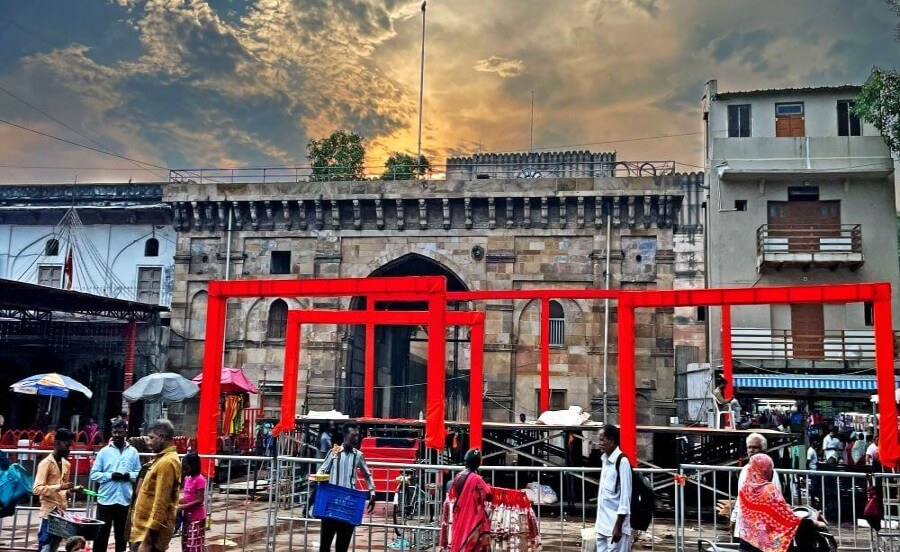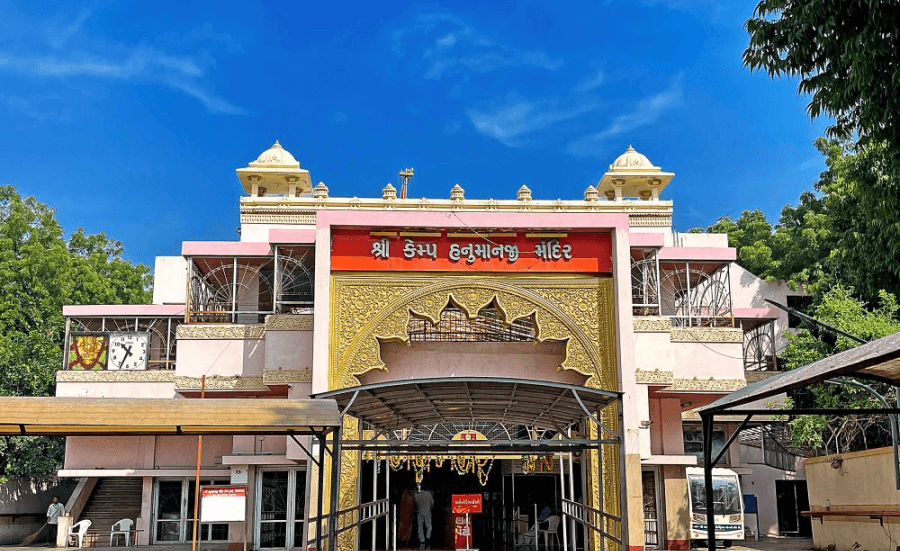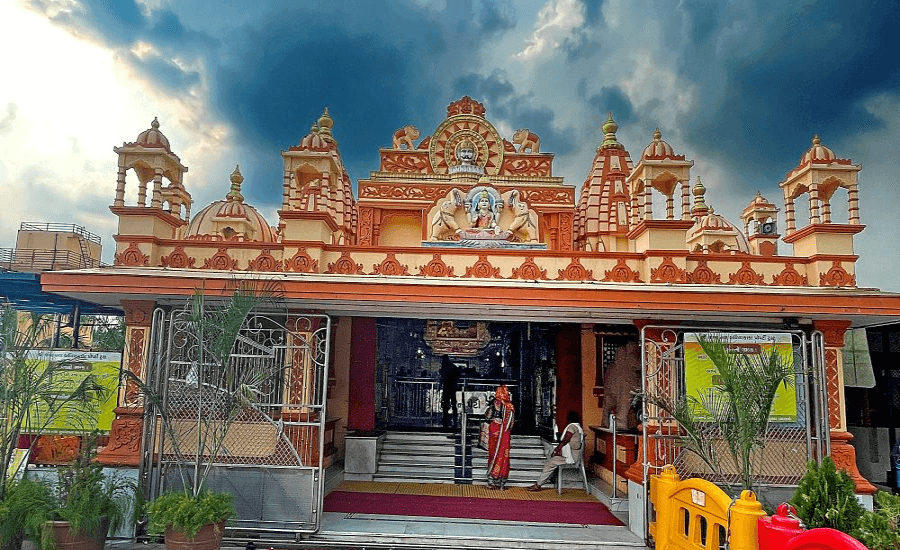
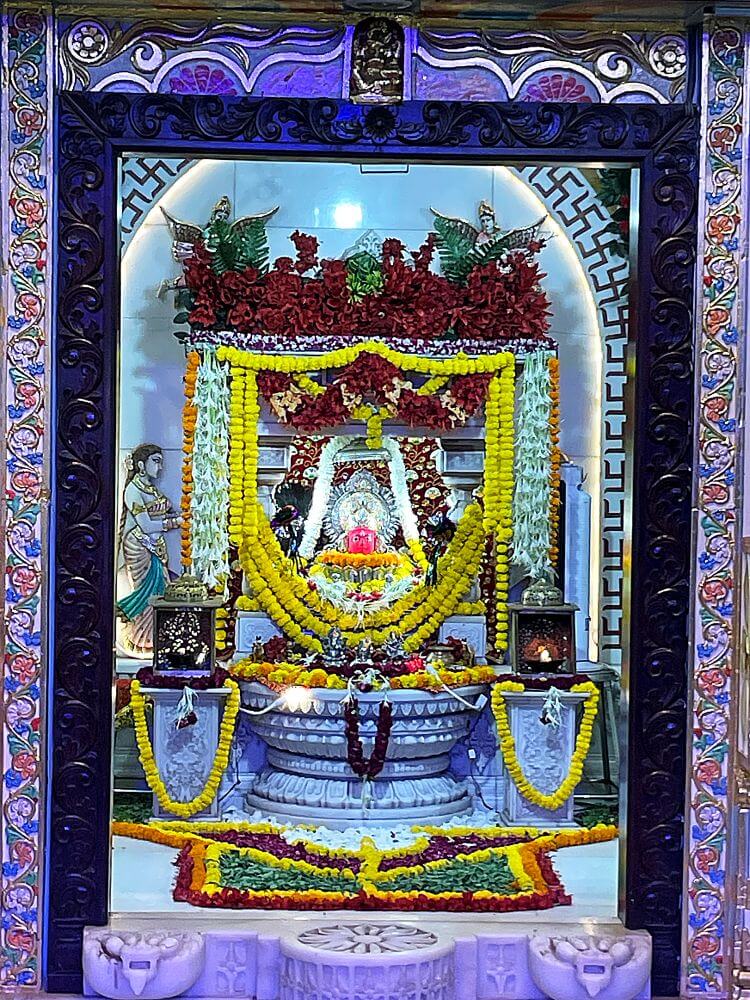 Lambha is a rural part of Ahmedabad city, home to the renowned Baliyadev Temple. It is also known as Lambha Temple or Baliyakaka Temple. For devotees in Gujarat, this deity is revered as Badiyadev, meaning the Great God. Throughout the year, especially on Sundays and during festivals, large crowds of devotees visit the temple. Worshippers from other states like Karnataka, Rajstan also come to seek blessings from Baliyadev. There is a strong belief that this deity fulfils wishes and cures children’s ailments.
Lambha is a rural part of Ahmedabad city, home to the renowned Baliyadev Temple. It is also known as Lambha Temple or Baliyakaka Temple. For devotees in Gujarat, this deity is revered as Badiyadev, meaning the Great God. Throughout the year, especially on Sundays and during festivals, large crowds of devotees visit the temple. Worshippers from other states like Karnataka, Rajstan also come to seek blessings from Baliyadev. There is a strong belief that this deity fulfils wishes and cures children’s ailments.
The Skanda Purana, in its Maheshwar Khanda tells the legend of Baliyadev. According to this tale, Baliyadev is the son of Bhima and Hidimba. Following Lord Krishna’s advice, Bhima arranged the marriage of his son, Ghatotkacha, to the beautiful Maurvi, also known as Kamkantaka. Maurvi was the daughter of Mura, the general of Narakasura, the king of Pragjyotishpura. Ghatotkacha and Mura’s son, Baliyadev, was born fully grown, with curly hair, and was thus named Barbarik. In the ancient texts, the tribal communities such as the Shabaras, Pulindas, and Kiratas were referred to as Barbaras. Barbarik was a great warrior. Through the worship of the goddess Siddhambika, he gained divine boons.
At the beginning of the Mahabharata war, Lord Krishna asked all the warriors how long they would take to defeat the Kauravas and their army.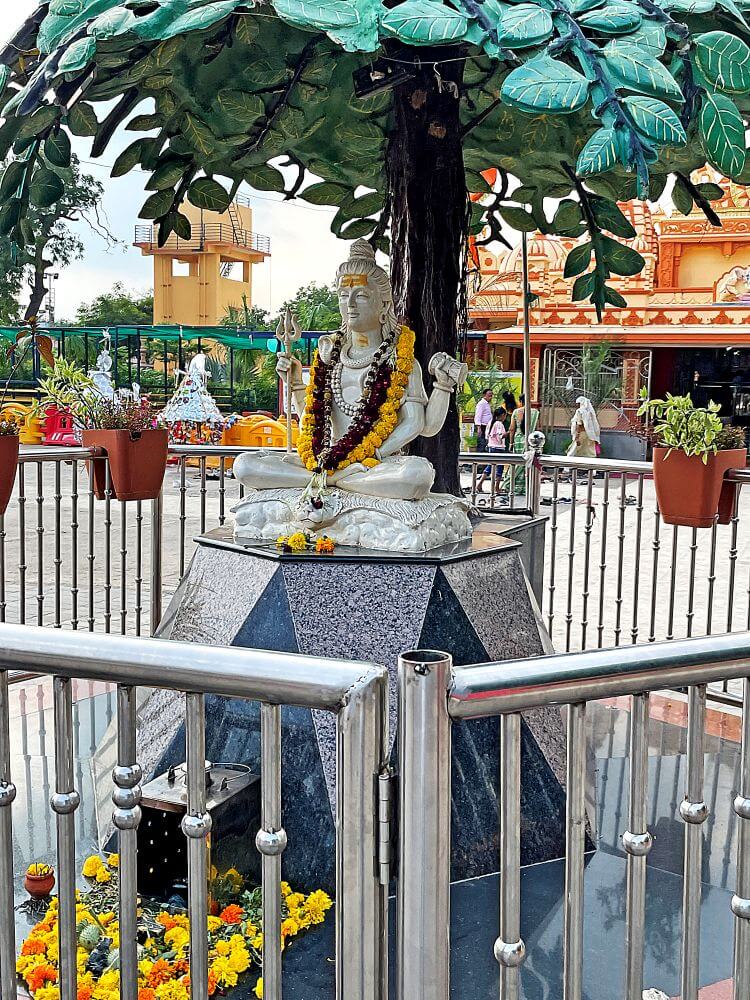 Barbarik replied that he could destroy them all in a few moments. The goddess Siddhambika had gifted Barbarik three infallible weapons: a divine bow, an inexhaustible (akshayya) quiver of arrows, and a sword. The red ashes applied to his arrows would reveal the weak points (marmasthan) of the enemy. When Barbarik demonstrated his powers, he was able to target everyone except the five Pandavas, Kripacharya, and Ashwatthama. Seeing this, Lord Krishna used his Sudarshan Chakra to sever Barbarik’s head from his body. Ghatotkacha mourned the death of his son, but the goddess Siddhambika explained that Barbarik had been a Yaksha in a previous life and was cursed to die at Krishna’s hands. Krishna then asked the goddess to sprinkle nectar on Barbarik’s head, making him immortal like Rahu. As a result, Barbarik’s head remained alive, and Krishna proclaimed that as long as the earth, stars, moon, and sun existed, people would continue to worship him. Today, Barbarik, the heroic deity, is worshipped in Gujarat as Baliyadev, and in Rajasthan as Khatu Shyamji. In Nepal he is known as Kiratraja Yalamber or Akash Bhairav.
Barbarik replied that he could destroy them all in a few moments. The goddess Siddhambika had gifted Barbarik three infallible weapons: a divine bow, an inexhaustible (akshayya) quiver of arrows, and a sword. The red ashes applied to his arrows would reveal the weak points (marmasthan) of the enemy. When Barbarik demonstrated his powers, he was able to target everyone except the five Pandavas, Kripacharya, and Ashwatthama. Seeing this, Lord Krishna used his Sudarshan Chakra to sever Barbarik’s head from his body. Ghatotkacha mourned the death of his son, but the goddess Siddhambika explained that Barbarik had been a Yaksha in a previous life and was cursed to die at Krishna’s hands. Krishna then asked the goddess to sprinkle nectar on Barbarik’s head, making him immortal like Rahu. As a result, Barbarik’s head remained alive, and Krishna proclaimed that as long as the earth, stars, moon, and sun existed, people would continue to worship him. Today, Barbarik, the heroic deity, is worshipped in Gujarat as Baliyadev, and in Rajasthan as Khatu Shyamji. In Nepal he is known as Kiratraja Yalamber or Akash Bhairav.
Lambha is considered a significant site for the worship of Baliyadev. There is also a story behind the establishment of this temple. Around eight decades ago, a terrible infectious disease plagued the village, and many children fell gravely ill, including the son of a respected villager, Purushottamdas. 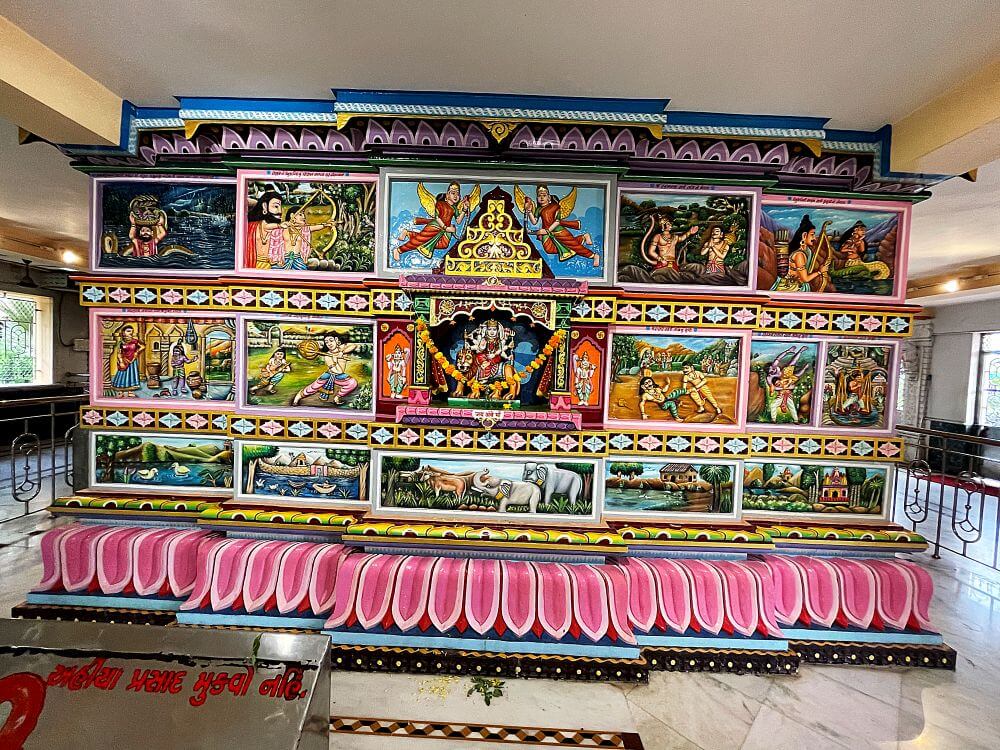 With the help of his friend Khodabhai, he enshrined the head of Baliyadev at the village. After performing a collective prayer, Baliyadev was pleased, and within nine days, all the children recovered. Following this event, a temple was built for Baliyadev. It is said that the deity was originally called as Badiyadev (the Great God), later became known as Baliyadev. Even today, devotees believe that if sick children are brought to this temple, Baliyadev will cure them within nine days.
With the help of his friend Khodabhai, he enshrined the head of Baliyadev at the village. After performing a collective prayer, Baliyadev was pleased, and within nine days, all the children recovered. Following this event, a temple was built for Baliyadev. It is said that the deity was originally called as Badiyadev (the Great God), later became known as Baliyadev. Even today, devotees believe that if sick children are brought to this temple, Baliyadev will cure them within nine days.
The current two-storeyed temple of Baliyadev, built in 1996, stands in a spacious complex in Lambha village. A grand double entrance built in in the Gurjar-Rajasthani architectural style leads to the temple compound. It has large elephant statues on either side. Above the gate is a statue of Goddess Gajalakshmi. 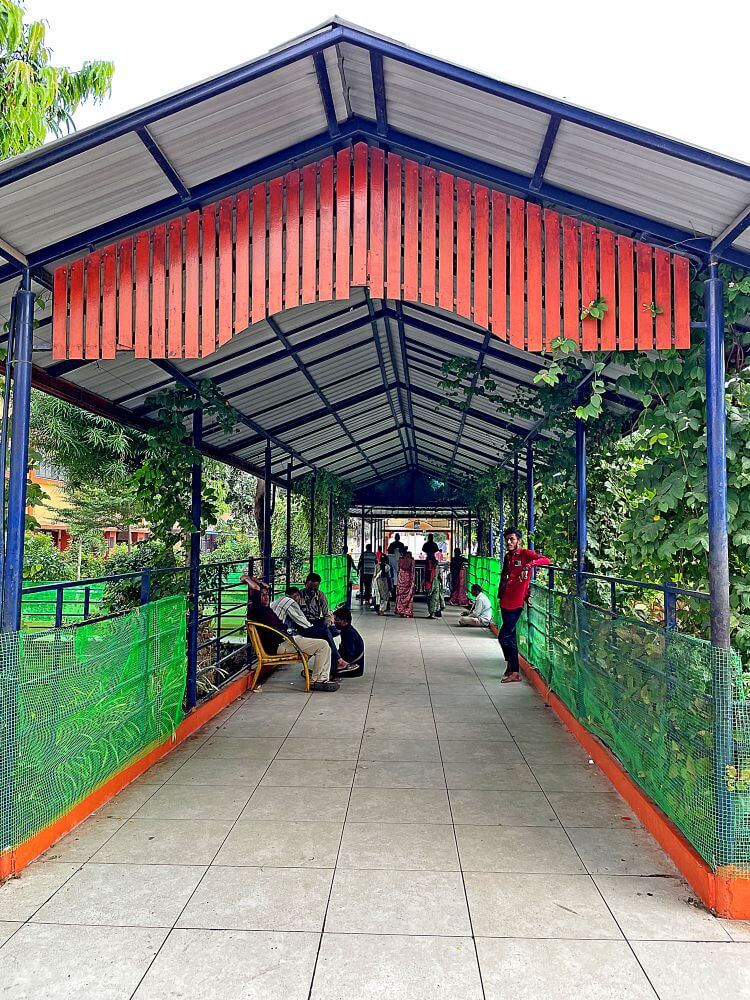 In the centre of the courtyard is a marble statue of Lord Shiva in deep meditation, sheltered by an artificial tree. A little further stands the multi-spired (shikhara) temple of Baliyadev. The temple has three main sections: the entrance hall (mukhmandap), assembly hall (sabhamandap), and sanctum (garbhagriha), all built on an elevated platform (adhisthan). A statue of Gajalakshmi adorns the roof of the entrance hall, and the idol of Baliyadev is placed in a circular arrangement inside. Red stone sculptures of elephants on marble platforms flank the entrance to the hall.
In the centre of the courtyard is a marble statue of Lord Shiva in deep meditation, sheltered by an artificial tree. A little further stands the multi-spired (shikhara) temple of Baliyadev. The temple has three main sections: the entrance hall (mukhmandap), assembly hall (sabhamandap), and sanctum (garbhagriha), all built on an elevated platform (adhisthan). A statue of Gajalakshmi adorns the roof of the entrance hall, and the idol of Baliyadev is placed in a circular arrangement inside. Red stone sculptures of elephants on marble platforms flank the entrance to the hall.
Upon climbing five steps, devotees enter the assembly hall, which has a semi-open design with seating areas (kakshasana) for rest. The assembly hall is beautifully adorned with square marble pillars, intricately carved arches (makartoran), and shining marble floors. There are two smaller shrines in the hall: one on the left for Lord Ganesha and another on the right for Lord Hanuman. Due to the large number of devotees, a steel railing system has been installed to facilitate orderly darshan (viewing of the deity).
Above the assembly hall, a balcony-like structure features rows of snake carvings. The outer walls of the sanctum are decorated with colourful vine motifs, along with raised relief carvings of Ganesha and Krishna advising Arjuna. Above the entrance, a large relief carving of Krishna driving Arjuna’s chariot is placed, surrounded by vibrant floral decorations. 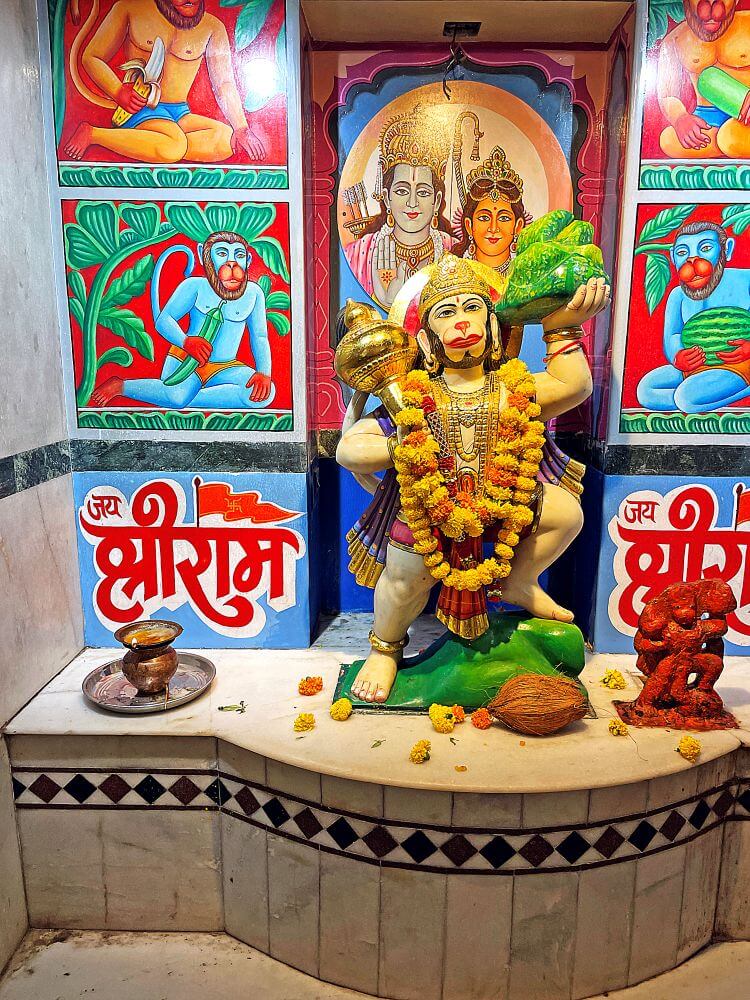 On the door frames, statues of gatekeepers (dwarpala) Jay and Vijay are carved, with Ganesha depicted above. The main idol of Baliyadev is enshrined on a silver seat (padma stambha), within an ornate canopy. Outside the sanctum, on the external walls, there are statues of goddesses Sheetala, Amba, and Khodiyar Mata. These walls also feature colourful reliefs depicting various stories from the Mahabharata, which devotees can view while walking around the sanctum.
On the door frames, statues of gatekeepers (dwarpala) Jay and Vijay are carved, with Ganesha depicted above. The main idol of Baliyadev is enshrined on a silver seat (padma stambha), within an ornate canopy. Outside the sanctum, on the external walls, there are statues of goddesses Sheetala, Amba, and Khodiyar Mata. These walls also feature colourful reliefs depicting various stories from the Mahabharata, which devotees can view while walking around the sanctum.
Due to the high number of devotees visiting the temple, long counters have been set up under a large canopy outside the temple for breaking coconuts, a common offering to the deity.
At this temple, boondi a sweet made from fried chickpea flour balls) is produced on a large scale using machines. Devotees purchase boondi ladoos (sweet balls made from boondi) as sacred offerings (prasadam) from a large Prasadalaya (food distribution centre) within the temple grounds. Behind the temple, a large pavilion has been built where visitors can rest and eat. On Sundays and Tuesdays, it is customary to eat Thandu Bhojan in the temple grounds. Thandu Bhojan refers to meals prepared the previous day, including snacks like farsan, pani puri, thepla, puri-bhaji, dahi vada, etc.
Krishna Janmashtami, Parivartini or Jaljhulni Ekadashi (Bhadrapada Shukla Ekadashi), Holi, and Vasant Panchami are celebrated with great enthusiasm at this temple. On these occasions, as well as every Sunday, large crowds of devotees gather at the temple. Devotees can visit the Lambha Baliyadev temple daily from 6:30 AM to 7:30 PM for darshan (viewing of the deity).
